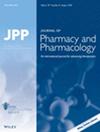Madecassoside modulates lipid metabolism in visceral adipocytes: exploring the browning, lipolysis, and lipogenesis mechanisms for potential obesity treatment
IF 2.8
4区 医学
Q2 PHARMACOLOGY & PHARMACY
引用次数: 0
Abstract
Objectives Madecassoside (MA) is a triterpene derived from Centella asiatica that has been recognized for its antioxidant and anti-inflammatory properties in various disease models. However, its direct impact on cultured white adipocytes and the underlying mechanisms, mainly through gene knockdown, have not been thoroughly explored. Methods Western blot analysis was utilized to assess the expression levels of various proteins, while oil red O staining was used to measure lipid deposition. The adipocyte shapes were confirmed using H&E staining. Key findings MA treatment enhanced browning and lipolysis in 3T3-L1 adipocytes and adipose tissue from experimental mice while suppressing lipogenesis. Furthermore, MA treatment increased the expression of PPARα and FGF21 in 3T3-L1 adipocytes as well as the secretion of FGF21 into the culture medium. Knockdown of PPARα or FGF21 using siRNA diminished the effects of MA on lipid metabolism in cultured adipocytes. Conclusions These findings demonstrate that MA promotes thermogenic browning and lipolysis while inhibiting adipocyte lipogenesis, thus showing the potential for attenuating obesity. The study suggested that MA could be a viable therapeutic approach for treating obesity.麦迪卡索苷调节内脏脂肪细胞的脂质代谢:探索潜在肥胖症治疗的褐变、脂肪分解和脂肪生成机制
目的 马黛茶苷(MA)是从积雪草中提取的一种三萜类化合物,它在各种疾病模型中的抗氧化和抗炎特性已得到公认。然而,它对培养的白色脂肪细胞的直接影响及其内在机制(主要是通过基因敲除)尚未得到深入探讨。方法 利用 Western 印迹分析评估各种蛋白质的表达水平,同时利用油红 O 染色测量脂质沉积。用 H&E 染色法确认脂肪细胞的形状。主要发现 MA 处理增强了 3T3-L1 脂肪细胞和实验小鼠脂肪组织的褐变和脂肪分解,同时抑制了脂肪生成。此外,MA 处理还能增加 PPARα 和 FGF21 在 3T3-L1 脂肪细胞中的表达以及 FGF21 在培养液中的分泌。使用 siRNA 敲除 PPARα 或 FGF21 可减弱 MA 对培养脂肪细胞脂质代谢的影响。结论 这些研究结果表明,MA 在抑制脂肪细胞脂肪生成的同时,还能促进产热性褐变和脂肪分解,因此具有减轻肥胖的潜力。研究表明,MA 是一种治疗肥胖症的可行方法。
本文章由计算机程序翻译,如有差异,请以英文原文为准。
求助全文
约1分钟内获得全文
求助全文
来源期刊
CiteScore
6.60
自引率
0.00%
发文量
91
审稿时长
3 months
期刊介绍:
JPP keeps pace with new research on how drug action may be optimized by new technologies, and attention is given to understanding and improving drug interactions in the body. At the same time, the journal maintains its established and well-respected core strengths in areas such as pharmaceutics and drug delivery, experimental and clinical pharmacology, biopharmaceutics and drug disposition, and drugs from natural sources. JPP publishes at least one special issue on a topical theme each year.
文献相关原料
| 公司名称 | 产品信息 | 采购帮参考价格 |
|---|

 求助内容:
求助内容: 应助结果提醒方式:
应助结果提醒方式:


